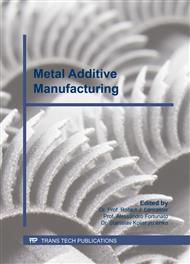[1]
J.M. Cai, G.B. Mi, F. Gao, H. Huang, J.X. Cao, X. Huang, C.X. Cao, Research and development of some advanced high temperature titanium alloys for aeroengine, J. Mater. Eng. 44 (2016) 1-10.
Google Scholar
[2]
G.W. Kuhlman, Forging of titanium alloys, in: S.L. Semiatin (Eds.), Metalworking: Bulk Forming, ASM Handbook, ASM International, 2005, pp.331-353.
DOI: 10.31399/asm.hb.v14a.a0004000
Google Scholar
[3]
A. Ducato, G. Buffa, L. Fratini, R. Shivpuri, Dual phase titanium alloy hot forging process design: experiments and numerical modeling, Advances in Manufacturing 3 (2015) 269–281.
DOI: 10.1007/s40436-015-0127-0
Google Scholar
[4]
S.L. Semiatin, V. Seetharaman, I. Weiss, The thermomechanical processing of alpha/beta titanium alloys, JOM 49 (1997) 33-39.
DOI: 10.1007/bf02914711
Google Scholar
[5]
R.R. Boyer, An overview on the use of titanium in the aerospace industry, Mater. Sci. Eng. A 213 (1996) 103–114.
Google Scholar
[6]
I. Gibson, D. Rosen, B. Strucker, Additive Manufacturing Technologies: 3D Printing, Rapid Prototyping, and Direct Digital Manufacturing, Springer, New York, (2014).
DOI: 10.1007/978-1-4939-2113-3
Google Scholar
[7]
D.M. Busch, E.V. Roegner, E.L. Colvin, L.N. Mueller, R.J. Rioja, B.H. Bodily, Methods for producing forged products and other worked products, Patent PCT/US2014/045952. (2015).
Google Scholar
[8]
D.S.E. Di, L. Duperray F. Perrier, C. Desrayaud, Method for the production of parts made from metal or metal matrix composite and resulting from additive manufacturing followed by an operation involving the forging of said parts, Patent PCT/FR2015/051087. (2015).
Google Scholar
[9]
S.L. Semiatin, P.A. Kobryn, E.D. Roush, D.U. Furrer, T.E. Howson, R.R. Boyer, D.J. Chellman, Plastic Flow and Microstructure Evolution during Thermomechanical Processing of Laser-Deposited Ti-6Al-4V Preforms, Metall. Mater. Trans. A 32 (2001) 1801-1811.
DOI: 10.1007/s11661-001-0156-0
Google Scholar
[10]
E.D Roush, P.A. Kobryn, S.L. Semiatin, Anisotropy of plastic flow and microstructure evolution during hot working of laser-deposited Ti-6Al-4V, Scr. Mater. 45 (2001) 717-724.
DOI: 10.1016/s1359-6462(01)01084-3
Google Scholar
[11]
J. Jiang, P. Hooper, N. Li, Q. Luan, C. Hopper, M. Ganapathy, J. Lin, An integrated method for net-shape manufacturing components combining 3D additive manufacturing and compressive forming processes, Procedia Eng. 207 (2017) 1182-1187.
DOI: 10.1016/j.proeng.2017.10.1050
Google Scholar
[12]
I. Sizova, M. Bambach, Hot workability and microstructure evolution of pre-forms for forgings produced by additive manufacturing, J. Mater. Process. Technol. 256 (2018) 154-159.
DOI: 10.1016/j.jmatprotec.2018.02.017
Google Scholar
[13]
M. Bambach, I. Sizova, F. Silze, M. Schnick, Hot workability and microstructure evolution of the nickel-based superalloy Inconel 718 produced by laser metal deposition. J. Alloys Compd. 740 (2018) 278-287.
DOI: 10.1016/j.jallcom.2018.01.029
Google Scholar
[14]
S.L. Semiatin, V. Seetharaman, I. Weiss, Flow behavior and globularizationkinetics during hot working of Ti–6Al–4V with a colony alpha microstructure, Mater. Sci. Eng. A 263 (1999) 257–271.
DOI: 10.1016/s0921-5093(98)01156-3
Google Scholar
[15]
I. Weiss, E.H. Froes, D. Eylon, G.E. Welsch, Modification of Alpha Morphology in Ti–6Al–4V by Thermomechanical Processing, Metall. Mater. Trans. A 17 (1988) 1935–(1947).
DOI: 10.1007/bf02644991
Google Scholar
[16]
F. Dyment, C.M. Libanati, Self-diffusion of Ti, Zr, and Hf in their hcp phases, and diffusion of Nb 95 in hcp Zr, J. Mater. Sci. 3 (1968) 349–359.
DOI: 10.1007/bf00550978
Google Scholar
[17]
C.H. Park, Y.G. Ko, J.W. Park, C.S. Lee, Enhanced superplasticity utilizing dynamic globularization of Ti–6Al–4V alloy, Mater. Sci. Eng. A 496 (2008) 150–158.
DOI: 10.1016/j.msea.2008.05.001
Google Scholar
[18]
H. Matsumoto, L. Bin, S.-H. Lee, Y. Li, Y. Ono, A. Chiba, Frequent Occurrence of Discontinuous Dynamic Recrystallization in Ti-6Al-4V Alloy with α' Martensite Starting Microstructure, Metall. Mater. Trans. A 44 (2013) 3245-3260.
DOI: 10.1007/s11661-013-1655-5
Google Scholar
[19]
N.K. Park, J.-T. Yeom, Y.-S. Na, Characterization of deformation stability in hot forging of conventional Ti–6Al–4V using processing maps, J. Mater. Process. Technol. 130 (2002) 540-545.
DOI: 10.1016/s0924-0136(02)00801-4
Google Scholar
[20]
J. Luo, M. Li, H. Li, W. Yu, Effect of the strain on the deformation behavior of isothermally compressed Ti–6Al–4V alloy, Mater. Sci. Eng. A 505 (2009) 88–95.
DOI: 10.1016/j.msea.2008.11.001
Google Scholar



